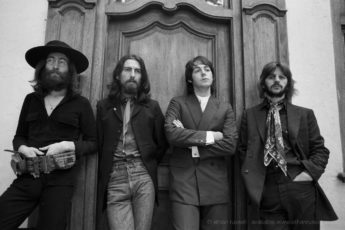
The Doors burst into my world like a supernova for but a few magical years, much like the incredibly brief lifespan of the band itself, which disintegrated with the exceedingly predictable death of iconic frontman Jim Morrison of, well, that depends on who or what you believe. Unless you’re Oliver Stone.¹ Only my Doors obsession didn’t correspond with the band’s actual reign – from 1967 with the self-titled debut through six majestic, unforgettable albums up to “L.A. Woman,” which marked their end in 1971. No, I listened to The Doors incessantly around the turn of the ‘80’s. And apparently, for some reason, I wasn’t alone. On September 17, 1981, Rolling Stone magazine’s entrancing cover was a close-up photo of a brooding Morrison, beside the indelible caption, “He’s hot, he’s sexy, and he’s dead.”
In fact, Morrison had been dead for almost exactly 10 years to that point. Yet the resurgence of The Doors and their captivating, poet/philosopher neo-deific leader – their resurrection, if you will – was unmistakable, even if unexplainable.² Though in truth, in my case there actually had been a logical corollary: those years coincided exactly with my ascension to college, and with it some of the experimentation one often associates with that time. There’s Pink Floyd, the Grateful Dead, and a handful of others, to be sure, but to me there’s never been a better band to complement such exploration than The Doors. If you’ve ever closed your eyes while listening to ‘When The Music’s Over’ and ‘The End,’ for instance, I think you know what I mean.
When I returned home from my first school break I got together with Verner and Ricky, two close neighbors and closer friends with whom I’d spent a ton of time throughout our formative younger years, all in completely straight-arrow activities. Yet in discussing our initial forays into college life (in Austin, Boston, and New Orleans, as it happens), we quickly realized we’d independently made the same two critical discoveries while away: weed and The Doors. They went together like, well, like weed and The Doors do! We listened to their unconventional, psychedelic blues/rock albums together a lot, and we were all engrossed with the just-out, first-ever biography of Morrison, “No One Here Gets Out Alive,” which provided exquisite detail on someone undeniably among the most remarkable, sensationalistic, and now mythologized characters ever to be created – in my view, in either non-fiction or fiction! Morrison’s matter-of-fact fixation with death, starting from a bizarrely early age, and his utterly inhuman consumption of alcohol, regularly swilling a quart of whiskey just to wash down his dinner, were but two aspects of the wild, mystical, rebellious, totally erratic, and still brilliant creative life that made him a rock legend in the truest sense, both when he joined the tragic 27 Club club upon dying and when his artistry and exploits were rediscovered by me and another generation of wonderstruck observers.
All of which leads me to a night back at college, the following year, when I was sharing an apartment with roomies Froydee and Chin. Froydee and I were in the living room, enjoying a little of Morrison’s inimitable poetry (it’s far from his best work, but did you know that “Mr. Mojo Risin’” was an anagram of “Jim Morrison”?), along with, shall we say, the appropriate accompaniments; Chin was in his room, having turned in early to prepare for a first-period morning exam. On the turntable was the “L.A. Woman” album, a record filled with the level of monumental songs one would expect to reflect the end of the band’s equally epic 4-year run.
But we’d reached the first track of side two, ‘L’America,’ which was a complete outlier, a tune closer in nature to the incoherently-produced recited composition of “An American Prayer” which would be released posthumously, and deemed so awful by us all as to be manifestly unlistenable. So naturally, Froydee and I cranked the volume up to its maximum (to 11, Spinal Tap fans), opened the door to Chin’s bedroom, and with the benefit of a fortuitously long cord, placed a speaker inside his room while locking the door behind it. And then proceeded to giggle uncontrollably like we’d been administered laughing gas, as Chin’s walls shook to the incessant drone of the excruciating song over and over (we may have also returned the needle to the beginning a few extra times).
Why, you may ask? That’s hard to pinpoint. But sometimes screwing over your friends in a seemingly malevolent way is just a weird guy thing, I think. That, or maybe it was the influence of Morrison, the incorrigible Lizard King. We still connect about it, the three of us, as recently as this week, in fact. And the part that probably most amuses Froydee and I, then and even all these years in retrospect, is that all Chin had to do to stop the Doors din and the Morrison madness was to unplug the speaker wires! They were in his room, we’d unwittingly ceded control, and an end to our hopelessly juvenile prank was entirely within his dominion. But sadly (for him) that obviously didn’t occur to Chin, and the now four-decade legend of ‘L’America’ was born. As the inscrutable Morrison was memorably characterized in “No One Here Gets Out Alive,” he delighted in “…probing the bounds of reality to see what would happen.” You might say that Froydee and I, admittedly in our own peculiar way, had done the same, and gotten way more out of it than we could’ve expected.
In closing, I’d really rather choose one of the dozens of incredible Doors tunes to feature here, but after that build-up how could I not offer you the haunting, ‘L’America’? And actually, as I listen to it again now, it’s not that bad. I think Chin really could’ve toughed it out and slept through it.
¹the circumstances of Morrison’s death, as well as the disposition of his remains, are still disputed and mysterious. Oliver Stone had his own definitive take, as he often does, in his 1991 biopic about the band, “The Doors”
²the statistics were impressive: every album in The Doors catalog doubled or tripled its sales in 1980 over the previous year






Anonymous
September 24, 2020 9:57 pmYou were such a Johnson. But I probably deserved it. Chin
Bill G.
September 24, 2020 10:09 pmBoth are true, Chinster!